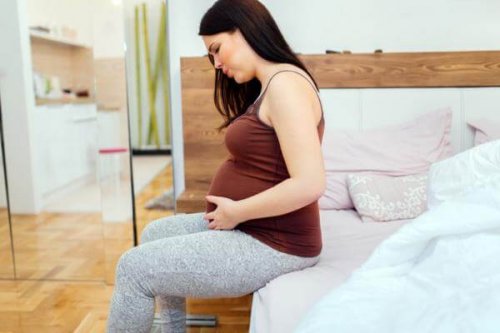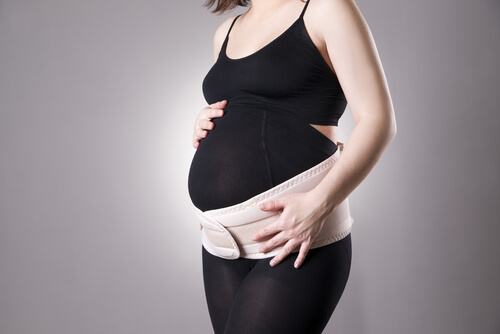Pelvic Pain during Pregnancy: Causes and Treatment Options

Pain in the pelvic region during pregnancy is one of the most common symptoms that appears during the gestation process. It is also known as diastasis symphysis pubis.
Although pelvic pain can appear at any time during pregnancy, it’s most common during a woman’s third trimester. This is the stage in which the body begins to prepare for the act of giving birth.
In today’s article, we want to explain why pelvic pain occurs during pregnancy.
We’ll also give you some tips to help prevent and relieve the discomfort this condition causes.
What causes pelvic pain during pregnancy?
While every woman‘s body prepares naturally for birth as the time approaches, it’s not the only cause for pelvic pain. Nor does it always explain the intensity of the pain.
Many factors can be responsible for producing pain and discomfort in the pelvic region. The intensity of this pain depends on several factors.
To understand how other factors can produce pelvic pain, first you need to know that the pelvis consists basically of two parts. These two parts are connected by a joint called the pubic symphysis.
As your due date nears, in your third trimester, your body releases a specific hormone in the pelvic region. This hormone, called relaxin, is responsible for relaxing the region’s ligaments.
Furthermore, it also causes the pubic symphysis to have more elasticity. As a result, the pelvic bones spread out more, allowing the baby to pass through during birth.

If there is a lot of separation between the pelvic bones, this can become diastasis symphysis pubis.
This condition doesn’t just depend on the degree of separation of the bones. Previous pregnancies can also play a role.
Some common factors that intensify pelvic pain during pregnancy
Belly size
Whether it be a big baby, twins, or simply a natural disposition, some women develop larger bellies during pregnancy.
The pelvis definitely feels the effects of a larger than average belly because it bears more weight.
Depending on the size of a woman’s belly, she may have intensified pelvic pain.
Existing excess weight
If a woman has a preexisting weight condition before getting pregnant, this can also contribute to pain in the pelvic region.
Extra weight can accentuate the burden that the pelvis has to carry. Even if diastasis symphysis pubis doesn’t exist, the weight itself can cause a pubic hernia.
As you can imagine, this will cause added pain in the region.
Daily exertion
The effort a woman’s muscles make on a daily basis can also bring on a pelvic hernia. These can come on suddenly and without warning.
Musculoskeletal illnesses
Musculoskeletal conditions can produce swelling in the pelvic region, which in turn causes pain during pregnancy.
Normally, pelvic pain during gestation doesn’t always have just one cause. This is especially true in the case of intense pain.
If the pain is very strong, then it may be due to excessive separation of the pelvic bones combined with another factor.
Whether directly or indirectly, these factors create pressure or sensitivity on the pelvis.
Tips for relieving and preventing pelvic pain during pregnancy
- Elastic belly band: The use of a belly band can help to reduce pressure on the pelvic zone. This lessens the pain and makes it easier to carry out daily activities. If a woman uses a belly brace from the beginning of pregnancy, this can even prevent pelvic pain altogether by eliminating overburden.

- Exercise the pelvis area: There are specific exercises that focus on preparing the pelvis to make childbirth simpler and less painful. These exercises strengthen the ligaments of the pubic symphysis. As a result, there is greater flexibility as the body stretches during gestation.
- Hydrotherapy: Hydrotherapy allows for the strengthening of the pelvic muscles during pregnancy. This relieves joint pain in the back and pelvis. Furthermore, it helps to also strengthen the joints in these areas thanks to the resistance that the muscles generate to the water’s movement.
- Take special care during pregnancy: It goes without saying that you should avoid vigorous exercise during pregnancy – not only to avoid pelvic pain, but also for the safety of your baby. However, maintaining good posture and avoiding high-heeled shoes is also important. And, of course, pregnant women should avoid tasks that involve lifting weight, bending over or squatting.
- Pain relief: Pain relievers are a good emergency option or last resort to calm your pelvic pain during pregnancy. They are mostly recommended when pain is very strong or imposes a noticeable interference on daily activities.
General considerations
During the third trimester, it’s especially important that women follow the instructions of a professional physical therapist before attempting any pelvis strengthening exercises.
This is to avoid any injury from overexertion or from doing the exercises the wrong way. Injury can make your present situation worse or cause pain in the future.
At the same time, it’s important that you check with your doctor before taking any pain relievers – or any medication for that matter.
That way, your doctor can tell you what options are safe during pregnancy and in what dosages.
Self-medication during pregnancy can be a great risk both for your baby’s development and your own health as well.
This text is provided for informational purposes only and does not replace consultation with a professional. If in doubt, consult your specialist.








